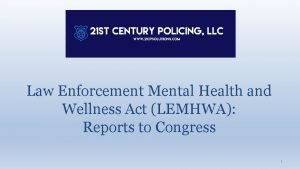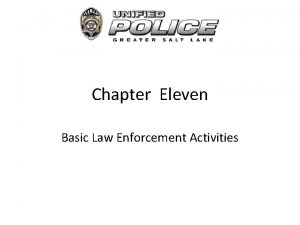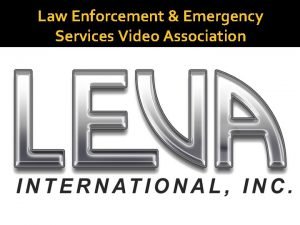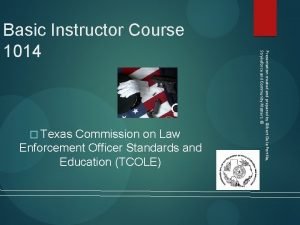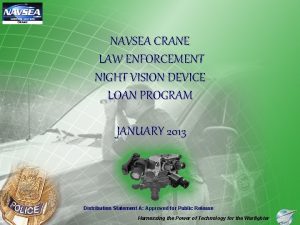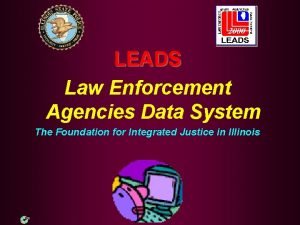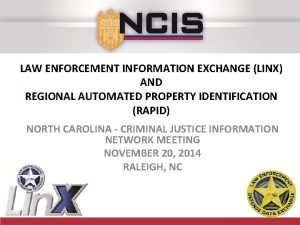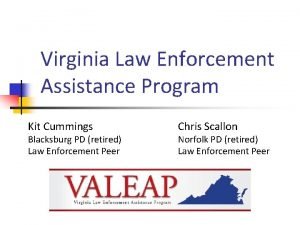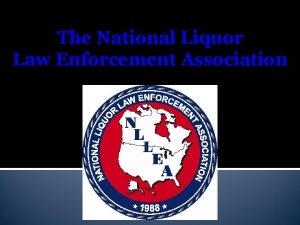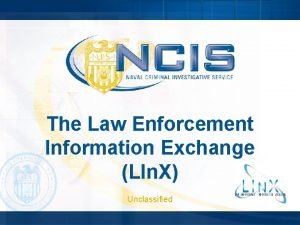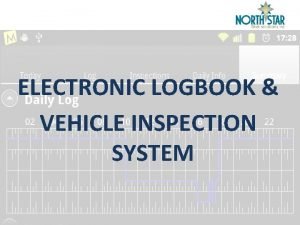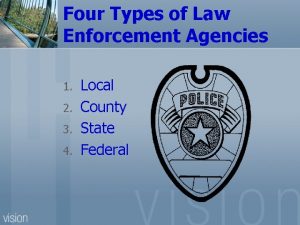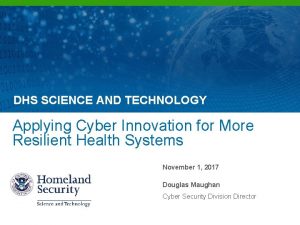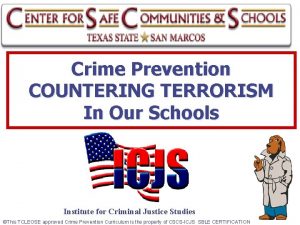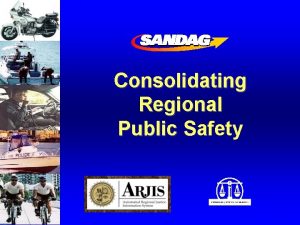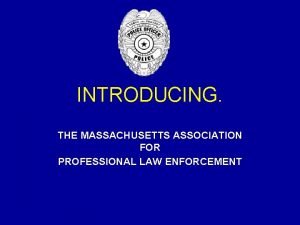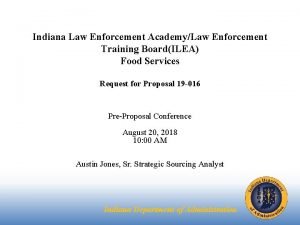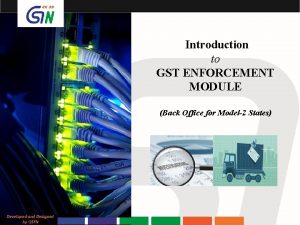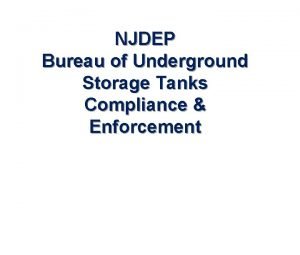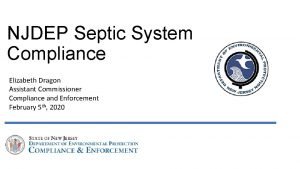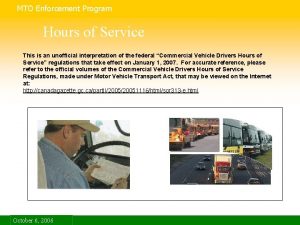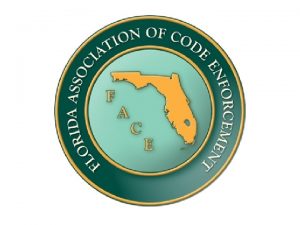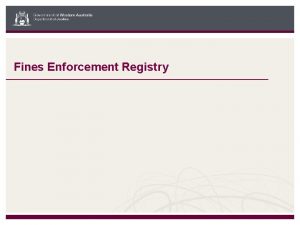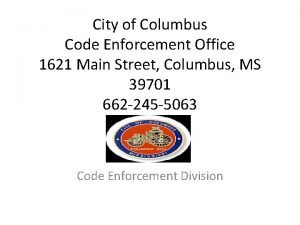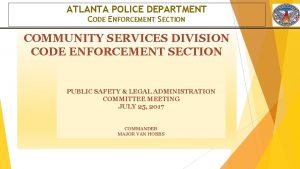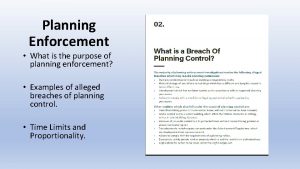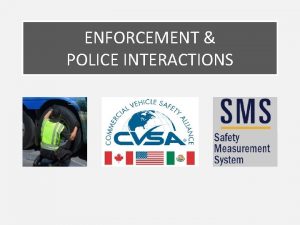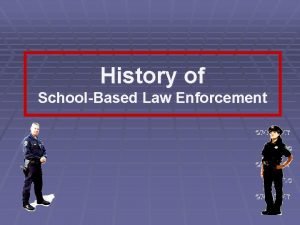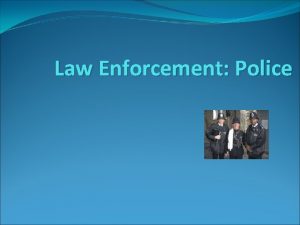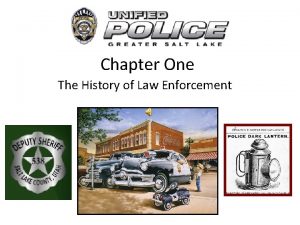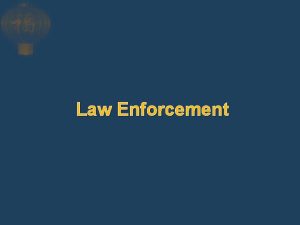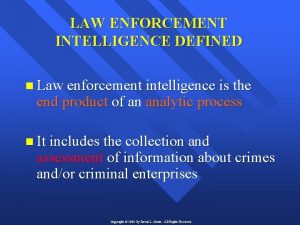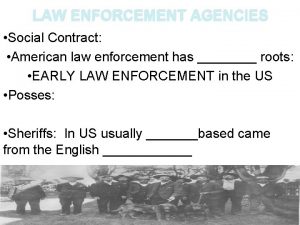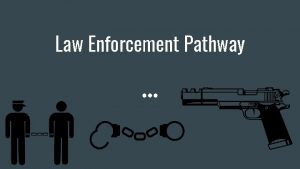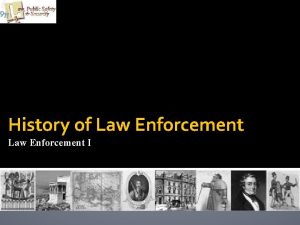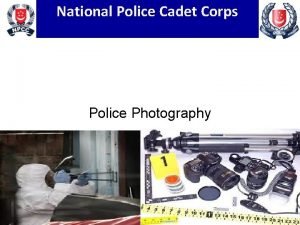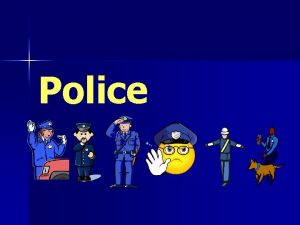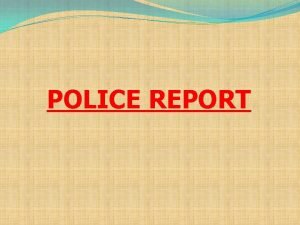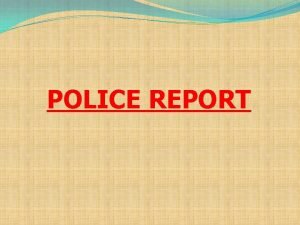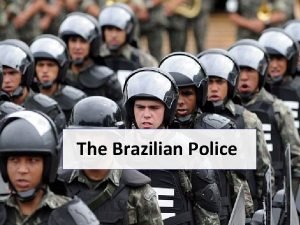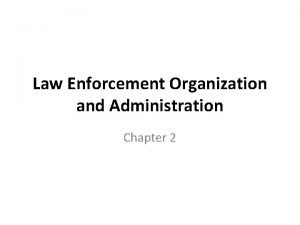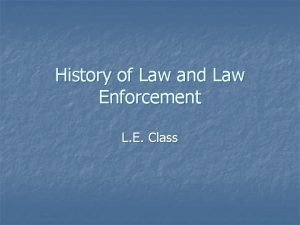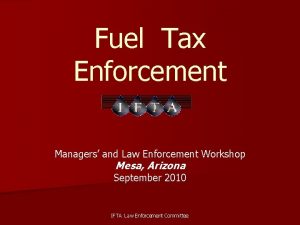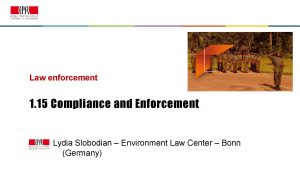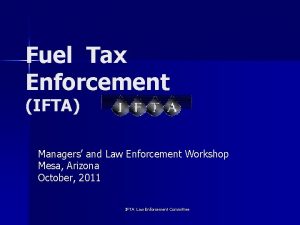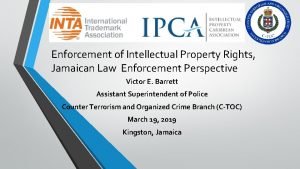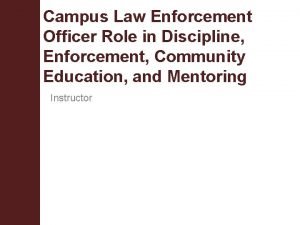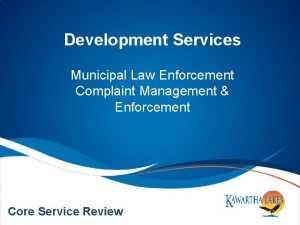Chapter 15 Police and Law Enforcement History of
































- Slides: 32

Chapter 15 Police and Law Enforcement

History of Police § • English origins The London Police § Sir Robert Peel (Act for Improving the Police) § London police were structured along military lines

History of Police • Policing in the American Colonies § Colonial policing paralleled the British model § County sheriffs collected taxes and supervised elections § Nightwatchmen became known as “leatherheads” § Watchmen were not widely respected

History of Police • Early American Police Agencies § Boston created first formal police agency in 1838, followed by New York in 1844 and Philadelphia in 1854 § Early police maintained public health and swept streets § Politics dominated most departments § Nineteenth century police were largely incompetent

History of Police • Reform Movements § Uniforms introduced in 1853 in New York § Use of telegraph and call boxes § Creation of police administration boards to reduce corruption § Boston police Strike of 1914 heightened police reform

History of Police • The Advent of Professionalism § Influence of August Vollmer and Orlando W. Wilson § Technological advances (bicycles, motorcycles, and cars) § Efforts in the 1960 s included highly trained and rule oriented police

Law Enforcement Agencies Today • Federal Law Enforcement § Federal Bureau of Investigation originated in 1908 through the Department of Justice § FBI was reorganized in 1930 under the direction of J. Edgar Hoover § The FBI is an investigative agency which offers assistance to local law enforcement

Table 15. 1 Full-Time Sworn in Law Enforcement Officers in the United States

Law Enforcement Agencies Today • Other Federal Agencies § Drug Enforcement Administration: Illegal drugs and importation of narcotics § U. S. Marshals: court officers § Alcohol, Tobacco, and Firearms Bureau: jurisdiction over sales and distribution § The Internal Revenue Service: Enforces violations of tax laws § Department of Homeland Security: Terrorism

Law Enforcement Agencies Today • Weblink http: //www. atf. gov/index. htm#

Law Enforcement Agencies Today • Directorates of Homeland Security § Border and Transportation Directorate • U. S. Customs • Immigration and Naturalization • Federal Protective Services • Transportation Security Administration • Federal Law Enforcement Training Center • Animal and Plant Health Inspection Service • Office for Domestic Preparedness

Law Enforcement Agencies Today • The Emergency Preparedness and Response Directorate § Federal Emergency Management Agency § Strategic National Stockpile and National Disaster Medical System § Nuclear Incident Response Team § Domestic Emergency Support Teams § National Domestic Preparedness Office

Law Enforcement Agencies Today • The Science and Technology Directorate § CBRN Countermeasures Programs § Environmental Measurements Laboratory § National BW Defense Analysis Center § Plum Island Animal Disease Center

Law Enforcement Agencies Today • The Information Analysis and Infrastructure Protection Directorate § Federal Computer Incident Response Center § National Communications System § National Infrastructure Protection Center § Energy Security and Assurance Program

Law Enforcement Agencies Today • County Law Enforcement § Sheriff evolved from the early English shire reeve § Nearly 293, 823 full-time employees § Executors of jails, and criminal and civil processes

Law Enforcement Agencies Today • State Police § Texas Rangers organized in 1835 § Created due to low regard for local police and mobility of violators § Nearly 56, 000 full-time officers in 49 departments (Hawaii has no agency)

Law Enforcement Agencies Today • Metropolitan Police § Vast majority of police with nearly 13, 000 departments and nearly 565, 000 full-time employees § Forty-six departments employ 1, 000 or more officers § Nearly 800 departments employ 1 officer

Figure 15. 1 Organization of a Typical Metropolitan Police Department

CNN Clip - Patrolling The Border

Police Functions • Patrol Function § Most visible presence (foot, cars, motorcycles, helicopters, and other mechanized methods) § Patrol is demanding and often unrewarding § Police have initiated methods to improve patrol • Proactive Policing • Full Enforcement/Zero Tolerance • Targeting Crimes • Making Arrests • Adding Patrol Officers

Police Functions • • Investigative Function § First established in London in 1841 § Detectives use various techniques to identify offenders § Specialization of sting and undercover operations Are Investigations Effective? § Rand Corporation study suggested most of investigation time is spent in unproductive work § Patrol officers solve most of the cases

Police Functions • • Changing the Police Role § James Q. Wilson suggests the major role of police is “handling the situation” Community-Oriented Policing § Wilson and Kelling contend policing should be proactive Implementing COP § Began with foot patrols § Neighborhood Watch Community Policing in Action § Federal government has encouraged community policing

Figure 15. 2 Police Encounters With Citizens

Police Functions • • Problem-Oriented Policing § Herman Goldstein suggested police are too concerned with internal efficiency § Problems should be narrowly defined Criminal Acts/Criminal Places § High-visibility patrols • Combating Auto Theft (GPS and other technology) • Reducing Violence (Gang Tactical Detail)

Police Functions • Does Community Policing Work? § Many police experts embrace community policing § Samuel Walker suggests many police consider community policing a waste of time § Many police still focus on the core concepts of fight crime and service work

Police and the Rule of Law • Custodial Interrogation § Miranda decision and the Fifth Amendment § Exceptions to the Miranda rule include: • Impeaching testimony due to perjury • Testimony resulting from defendant’s testimony • Only applies to legal representation, not priests or other public officials • Inevitable discovery • Public safety doctrine • Intentional misleading statements by police • Admonishment does not apply to all interrogations • Admissions of mentally impaired defendants • Attorney requests to see the defendant • People who are mentally ill • Interrogation after invoking Miranda rights • Harmless errors

Police and the Rule of Law • Search and Seizure § Search warrants are required under common circumstances § Warrants are not required when: • A threshold of inquiry occurs (stop/frisk) • Incidental to an arrest • Automobile searches with probable cause • Motorist search • Consent given • Plain view • Nonphysical evidence (overheard conversations) • Hot pursuit/Exigency

Issues In Policing • Police Personality and Subculture § Personality includes: authoritarianism, suspicion, racism, hostility, insecurity, conservatism, and cynicism § Blue curtain subculture: Isolation and conflict may contribute to stress (Westly) § Police may learn to mistrust citizens § Hidden dangers and impact of moral solidarity (Crank) § Joining the subculture brings support from fellow officers (tough exterior and mistrusting motives) § Resistance to change

Issues In Policing • • • Police Style § Some officers are service oriented whereas others take a more active role in law enforcement Discretion § Selective enforcement affected by • Environmental and community factors • Departmental factors • Situational Influences • Legal factors • Race, Class, and Gender Limiting Discretion § Written rules § Civilian review boards

Issues In Policing • • • Women and Minority Police Officers § Compliance of federal guidelines have impacted the hiring of women and minority officers (near 20 percent of police) § Racial quotas (U. S. v. Paradise) Minority Officers § African Americans have less confidence in police than Whites § Black officers suffer “double marginality” Female Police Officers § Title VII led to the hiring of more female officers § Evaluations suggest women are equally or more effective than men in police work § Black women account for about 2 percent of police

Issues In Policing • • The Police and Violence § Verbal abuse by police was common but physical abuse by police is rare (Reiss study) § Use of weapons by police is rare § Blacks and Hispanics are more likely to experience threat of force more than Whites Deadly Force § Approximately 6600 civilians killed by police since 1976 • Exposure to threat and stress • Police workload • Firearm availability • Population type and density • Race and class discrimination • Lack of training and preparation

Issues In Policing • • • Controlling Force § Tennessee v. Garner (1985) prohibited shooting of unarmed felons § Development of administrative policies controlling deadly fire § Elaborate shooting review procedures § Federal Crime Control Act of 1994 Killing Police § 51 officers killed in 2000 § Nearly half while making arrests Nonlethal Weapons § Nearly 1000 local police forces have started using some nonlethal weapons (wood, rubber, or polyurethane bullets) § Research suggests nonlethal weapons may reduce use of force by police
 Lemhwa report to congress
Lemhwa report to congress Military and law enforcement
Military and law enforcement Military and law enforcement
Military and law enforcement Law enforcement and emergency services video association
Law enforcement and emergency services video association Texas commission on law enforcement
Texas commission on law enforcement Law enforcement night vision
Law enforcement night vision Leads provides access to
Leads provides access to Law enforcement information exchange
Law enforcement information exchange Virginia law enforcement assistance program
Virginia law enforcement assistance program Nllea
Nllea Law enforcement information exchange
Law enforcement information exchange Elvis vehicle inspection
Elvis vehicle inspection Law enforcement agencies
Law enforcement agencies Law enforcement first responder
Law enforcement first responder Law enforcement agency
Law enforcement agency Calphoto dmv law enforcement
Calphoto dmv law enforcement Massachusetts association for professional law enforcement
Massachusetts association for professional law enforcement Ilea dishes
Ilea dishes Gst law enforcement
Gst law enforcement Newton's first law and second law and third law
Newton's first law and second law and third law Newton's first law and second law and third law
Newton's first law and second law and third law Boyles law
Boyles law Avogadro's law constant
Avogadro's law constant Njdep compliance and enforcement
Njdep compliance and enforcement Njdep compliance and enforcement
Njdep compliance and enforcement Clares law west midlands police
Clares law west midlands police Second line enforcement adalah
Second line enforcement adalah Mto hours of service
Mto hours of service Florida association of code enforcement
Florida association of code enforcement Fines enforcement registry
Fines enforcement registry City of columbus code enforcement
City of columbus code enforcement Atlanta code enforcement
Atlanta code enforcement Planning enforcement
Planning enforcement
